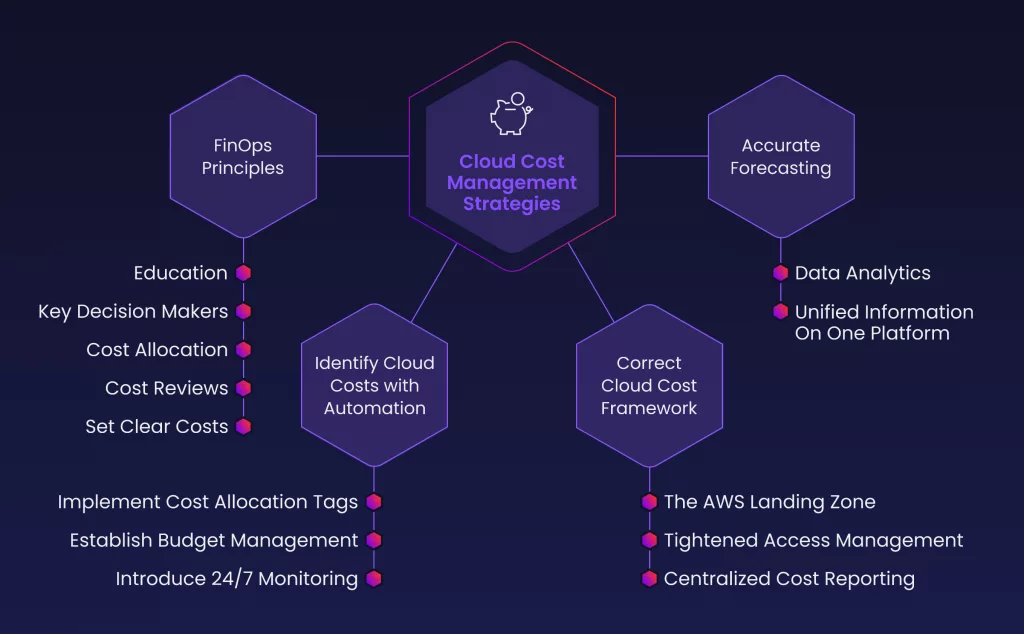
Cloud cost management strategies help to proactively manage your ongoing cloud costs as your cloud environment scales up or down. Once equipped with a robust strategy as the foundation of your cloud financial operations, you can say goodbye to surprising cloud bills and a lack of cloud management control. This article will answer the question of how does an organization manage cloud computing costs. The key components of cloud cost management strategies will be outlined. Optimize your cloud budget and increase the Return On Investment (ROI) of the cloud, without neglecting cloud security or your regulatory compliance with your industry’s standards.
What is cloud computing cost management?
Cloud computing cost management relates to the processes, methodologies, and rules you have in place to effectively manage your monthly cloud expenditure. Poor cost management looks like:
- A lack of visibility into what you’re paying for
- Sprialing cloud bills and blown budgets
- Not enough allocated time dedicated to monitoring your cloud costs
What is a cloud cost management strategy?
Using a strategized approach to cloud computing cost management helps to cover all bases, preventing any shock when you receive your AWS cloud bill. You’re working with a cost-focused foundation so you’re always being proactive, not reactive. This strategy needs to be bespoke to your needs as every organization has different requirements from the cloud and varying standards they need to meet.
It’s normal for your cloud bill to vary from month to month. Maybe you’ve onboarded new customers to your software or deployed a new testing environment for your app’s new version. The problem with changing cloud costs begins when you don’t know what caused this price change. This creates a slippery slope of unnecessary stress and confusion, when the original purpose of the cloud was to make our lives easier!

Successful components of cost management strategies
At StackZone, we’ve helped countless businesses accelerate the adoption of the cloud securely to meet their industry’s standards in a way that equips business owners with complete cloud cost control. This has been achieved with our software that has helped provide 35% cost reduction rate for our customers, on average, by optimizing cloud cost settings and usage. Whether or not you are using a cloud management platform, you should be implementing the following into your cloud cost management strategy:
1. Accurate forecasting of your cloud cost requirements
By accurately forecasting any changes in capacity, you can ensure you have the budget aside to support these changes. This all relates to cloud visibility; are you paying for any unused capacity such as forgotten instances or EBS volumes? How will you cope if you have a sudden spike in cloud storage caused by a change in capacity? It’s your role you have the balance of paying for enough cloud storage to handle a sudden increase in traffic but you’re not paying for excessive cloud waste.
How do I achieve this?
Data analytics is crucial to accurate cloud cost forecasting. Through analytics you can evaluate your usage, historic, in real-time, and forecasted. Part of your cloud cost management strategy needs a process to evaluate your cloud costs and optimize them so you can meet future requirements, collected by data analytics.
StackZone can help by having all your cloud cost information in one place, helping you to understand your bill, from one user-friendly interface. You have cloud cost visibility as well as expert recommendations on how to take your cloud budget further. It’s easy to identify and remove cloud waste or scale down resources in response to the analytics, helping to avoid overprovisioning.
2. Traceability with a cloud cost optimization framework
Costs begin to spiral when you neglect the maintenance of your cloud infrastructure. The landing zone is the perfect cloud cost optimisation framework. A landing zone is a multi account approach to cloud computing that securely segregates your cloud environment to facilitate a secure deployment. Using a single-account strategy is a limited framework because you miss out on the many benefits of the public cloud. Without a landing zone, you experience frustrations with increased security vulnerabilities, and complications with tracking cloud billing, and managing access.
What does a landing zone achieve for cloud cost?
- Tightens access management – The landing zone gives you greater control over the permissions over users. You follow the principle of least privilege which increases your security whilst prevents any costly mistakes by users making incorrect purchases. You’re essentially placing limits on what users can access, preventing the wrong person from making a cost decision they shouldn’t be making.
- Centralized cost reporting and analytics – Landing zones typically facilitate the use of consolidated billing and well-organized account structures. This allows organizations to manage their cloud expenses centrally, providing better visibility and control over spending across different projects, teams, or departments.
- Continuous improvement – Landing zones are designed to evolve and improve over time as cloud technologies and best practices change. As a result, organizations can benefit from ongoing cost optimization as the landing zone is updated with the latest cost-effective approaches.
How do I set up a landing zone to manage my cloud costs?
By using StackZone, our platform ensures a smooth set up of a perfectly configured landing zone. This helps to protect your cloud environment, and optimize your cloud budget within hours of set up.
3. A cost conscious culture through FinOps principles
Introducing Financial Operations principles can vastly improve your cost optimization. While cost tools are great (including our own!) without processes behind them, you will struggle to reach complete cost goals.
What is FinOps?
In the context of the cloud, FinOps is about managing the financial aspects of cloud resources. Cloud cost optimization is essential to FinOps as it helps organizations align cloud spending with business goals and outcomes. The objectives around FinOps are to create cost visibility, cost optimization, and careful cost allocation. It’s all about working in collaboration with different teams with one unified goal. Achieve that goal through following FinOps principles:
Educate your team
Educate all team members, not just the designated finance or cloud experts, about the principles and importance of FinOps. Make sure that developers, engineers, and other team members understand how their actions can impact cloud costs and how they can contribute to cost optimization.
Choose key decision makers
Designate key decision-makers within the team who are responsible for overseeing FinOps practices. This may include representatives from finance, operations, and technical teams. Having clear accountability ensures that there is ownership of cost management and optimization efforts.
Set clear cost goals
Define clear cost objectives aligned with business goals. These objectives could include optimizing cost per performance, setting budget limits for projects, or achieving specific cost reduction targets.
Implement cost allocation
Set up mechanisms to allocate cloud costs to different departments, projects, or teams. This transparency helps stakeholders understand their cost contributions and encourages responsible cloud resource usage.
Regular cost reviews and optimization
Schedule regular reviews of cloud costs and performance metrics. Analyze cost trends, identify inefficiencies, and implement optimization strategies accordingly. This fosters a culture of continuous improvement, helping you to unlock new milestones in the cloud.
4. Visibility powered by AWS cost features through automation
AWS have a multitude of powerful features that transform your cloud management. But these rely on cloud expertise; having a confident cloud expert in your team who can implement them in the right way. Using the StackZone console, you don’t need to rely on the cloud expert in your team. You can set up automation for cost features in a few clicks so your optimizing your cloud budget all times.
- Implementing cost allocation tags — Using tagging helps to categorize and track spending, keeping you in control. Tags are user-defined metadata assigned to cloud resources (such as virtual machines, storage volumes, databases, and more) within a cloud environment. Each tag consists of a key-value pair, and resources can have multiple tags associated with them. Tags also achieve starting or stopping instances according to schedules or events. You can assign tags to AWS resources to better categorize and track them. Manually assigning tags creates challenges. By automating the tagging process with StackZone you can unlock all the benefits of tagging in a few clicks without making any mistakes and forgetting a key area. This is particularly useful when your cloud environment starts to scale rapidly.
- Establishing budget policies — Setting a budget is one thing but sticking to it month after month can cause a headache. StackZone not only notifies you when you’re approaching the end of your budget but it actively helps you to optimize costs with cost-focused features so your cloud environment keeps working hard when you’re not looking at it. An example of these features is the Amazon EBS optimizer which will automatically optimize your Amazon EBS volumes and exchange older generation gp2 volumes with the newer and more cost efficient gp3 volumes. All of these features work collectively to take your budget further.
- Introducing 24/7 monitoring – Cloud cost management needs dedicated focus to not let cost anomalies cause chaos however it’s impossible to have your attention on your cloud environment at all times. That’s why StackZone monitors your cloud environment 24 hours a day for you. You have cloud cost insights at your fingertips with the creation of cost reports, so you’re always in the know about your cloud expenditure.
What does a cloud cost management strategy achieve?
Stress free scaling
The majority of scaling companies, that we see, have concerns about managing their cloud expenditure and cloud budget management. As you scale, you increase the number of accounts, projects, and the size of various teams. All these teams have different needs and usage patterns. It is crucial for scaling companies to closely monitor their usage and the costs associated with this. A cloud cost management strategy keeps all of this under control.
Optimized resource management
By appropriately right-scaling your resources with the aim of optimizing your cloud budget, you help to only pay for what you use out of the cloud. Part of this process involves taking advantage of reserved instances and savings plans to get the most out of cloud storage as well as relying on automation to automatically and dynamically scale your resources based on legitimate demand.
Complete visibility
When you have arranged a cloud cost management strategy, you deeply understand your cloud expenditure. This visibility functions as a springboard to introduce automation, tools, and cost-efficient processes to take your cloud budget further, putting an end to spiraling costs.
This visibility, achieved by a cloud cost management strategy, has a direct impact on your security level as well as your compliance achievement. As seen is this article, the landing zone is the infrastructure needed to control your cloud costs and it also functions as security framework, helping you to maintain a strong posture and visibility into the strength of every part of your cloud infrastructure.
How does StackZone help with cloud cost management strategies?
The AWS cost optimization software, StackZone, helps you set up your cloud cost management strategy by the automatic introduction of cloud cost best practices. You experience cost benefits within hours of the set up of StackZone with the many powerful features. The console provides complete visibility into the expenditure of all of your accounts and it assists in creating a cost-conscious culture.
Starting your journey to cloud cost optimization
A cloud cost management strategy should consist of cost management features, the correct cloud infrastructure, and a culture of cloud cost awareness with FinOps principles. Having a cost-focused approach will transform your AWS billing and prevent your budget being exceeded. To take your cloud budget further whilst increasing your security and cloud compliance, book a demo of StackZone, and a member of our team will take you through how it could help you.
This article was written by Gaston Silbestein, CRO of StackZone
